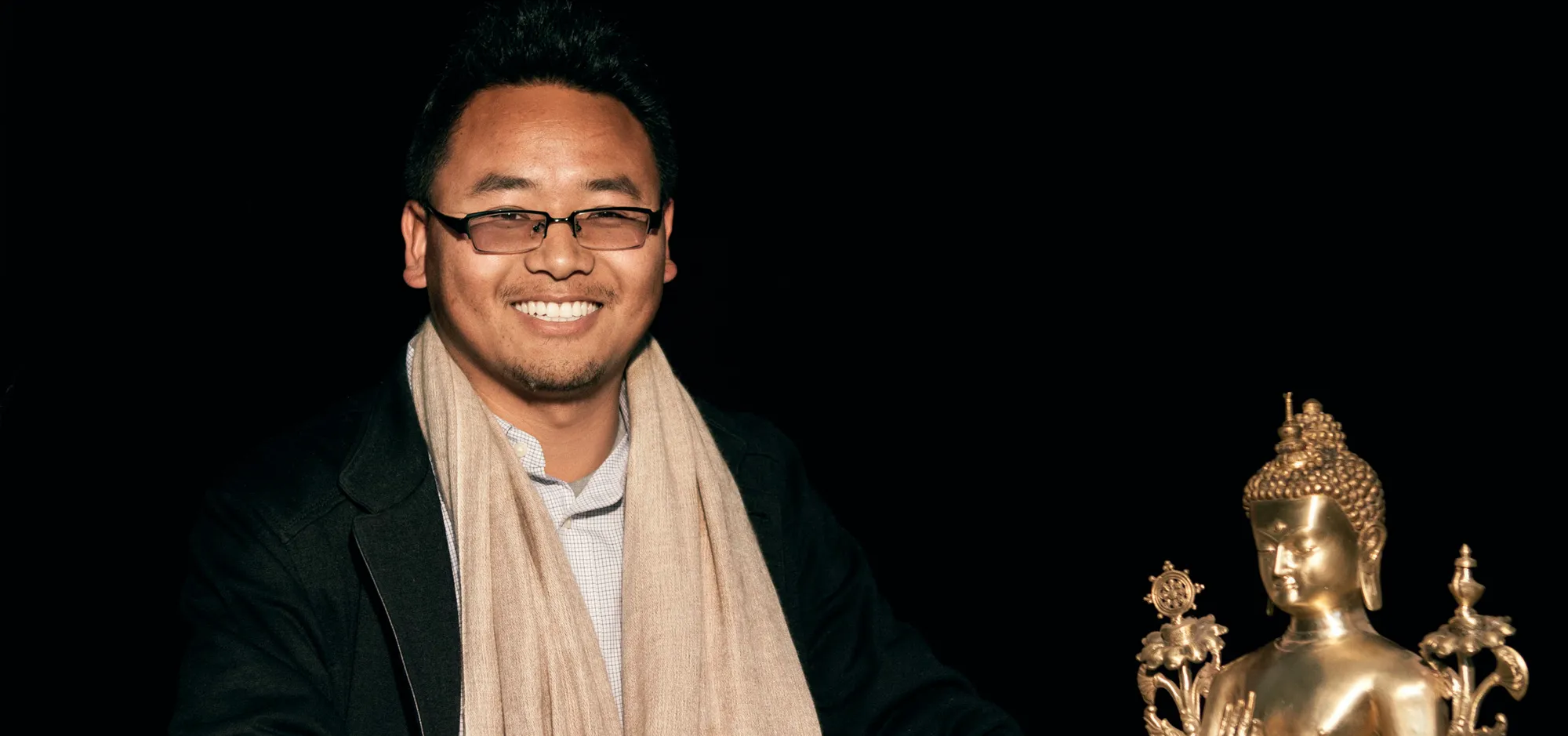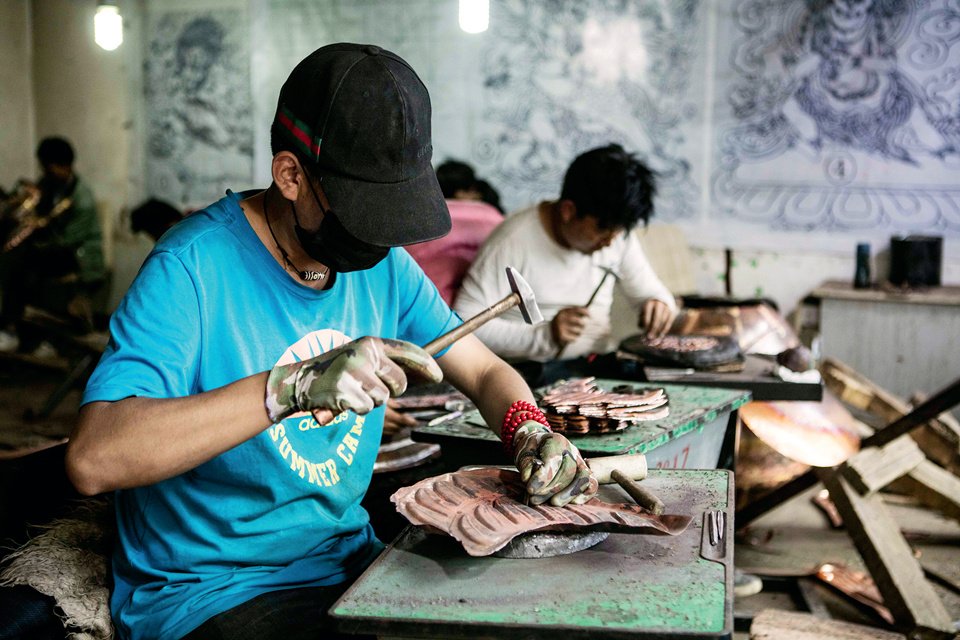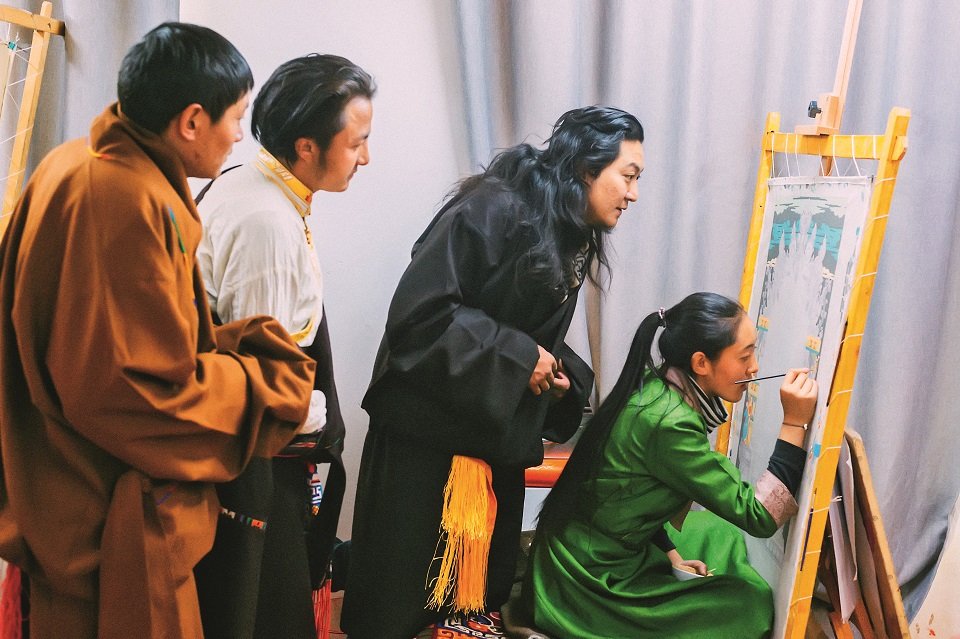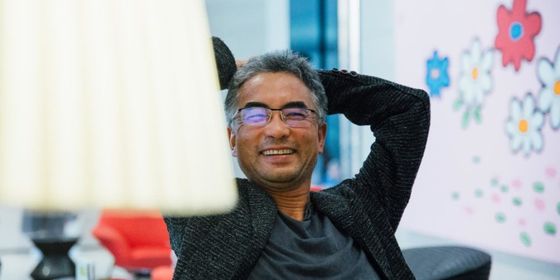Headmaster Yeshi Tenzin trains the next generation of Tibetan thangka artists in Lhasa
Rows of willow trees dotted by flowering cherry shrubs shelter the courtyard of the Xueduibai School for Traditional Arts and Crafts from Lhasa’s scorching sunshine. In a classroom on the ground floor, a dozen students sit in silence at their easels, diligently copying the Buddha’s portrait onto canvas.
Named after an ancient guild of craftsmen whose works decorated the Potala Palace and other temples and palaces in Tibet, the Xueduibai School is located in a quiet neighborhood in the north of Lhasa. Headmaster Yeshi Tenzin, also known as Yang Xiong (羊兄, “Sheep Brother”), oversees a rigorous curriculum for about 150 students, including the six-year training required to master thangka, a richly colored form of classical Tibetan painting on scrolls of silk or cotton.
Thangka is an art form that dates back at least to the seventh century and practiced across the Himalayas. Its ornate symbols and precise geometry showcase the history of Tibetan Buddhism, and are used to aid practitioners in seeking enlightenment through meditation and teaching.
Yeshi Tenzin’s own life has been shaped by the recent changes on the plateau: he is among the earliest generations of Tibetan students to have enrolled in the government’s free education program, which sends high-achieving Tibetan youths to attend schools in major cities. Having left Tibet as a sixth-grader in 1999, he returned after university to teach in a public secondary school near Lhasa, but later gave up this “iron rice-bowl” job to join Xueduibai as headmaster. His father was so angry about this decision that he didn’t speak to Yeshi Tenzin for six months.
Since 2015, Yeshi Tenzin has applied his passions toward building up a technical school for traditional Tibetan art and crafts. He is also the founder of TibetSheep, a popular Tibetan-language WeChat account with more than 400,000 followers, providing an outlet for Tibetan authors of all walks of life to share their writing.
Speaking calmly and precisely, as if articulating thoughts that had been brewing a long time, Yeshi Tenzin recounts to TWOC how traditional Tibetan culture and art can continue to flourish on the changing social landscape of the plateau.
What kind of students come to Xueduibai to study traditional craft?
Actually, perhaps just three students out of 10 come here out of genuine interest in the crafts. Most of our students were sent here by their families because they didn’t pass the high school entrance exam. Many had already taken up smoking, drinking, and street fighting. Coming here is a transition for them: If they can master the craft, that’s great; if not, at least the years they spend here could give them a new start.
There are Buddhist sculptures everywhere in our courtyard, and thangka and bodhisattvas in the classrooms. In this environment, even if they wanted to smoke, they would not do it in the school, out of respect. Some have felt the teachers’ compassion and kindness and slowly become good people over the course of a few years.
When it was first founded [in 2010], the school recruited orphans as students and became known as an orphanage, so my first big move as headmaster was to erase this reputation. Xueduibai is not an orphanage; it is a school that teaches traditional craft that happens to have many orphans as students. It took me three years to correct this impression, and then we started recruiting more students and reforming the curriculum to comply with the national schooling system.
Thangka emphasizes strict adherence to tradition. Does your curriculum allow innovation?
It takes five years to learn the basic drawing skills of thangka. Students must master the set of about 30 bodhisattvas and other deities, with fixed bodily proportions that are memorized through repetition.
Most thangka students will become artisans who follow the codes, conforming to people’s worship needs. Some talented artists will be able to innovate based on historical accounts, biographies, and Buddhist scriptures—imagining a bodhisattva in akasa [infinite space], or even enter into dialogue with the bodhisattva. This is something unique to thangka.
Modern art expresses personal emotions, but thangka cannot express your personal emotions. You can only express your awe toward the bodhisattva to give viewers a sense of compassion and tranquility. The trend of modern art is to express dissatisfaction with human nature and political systems, but someone who creates thangka has no distracting thoughts and few desires. The best thangka artist is a quiet creator who feels the nothingness of the world. They are incredibly rare to find.
What is your vision for Xueduibai’s future?
Last April, Xueduibai became the first registered private technical school in Tibet, and students graduating this year will be able to obtain a diploma issued by the Ministry of Human Resources and Social Security. Right now, the school doesn’t charge tuition and operates at a deficit. [In 2021], with the permit to operate a technical school, we are hoping to get government funding based on enrollment, and that would be a big relief financially.
We will also charge tuition and set up programs according to market demand, so that graduates can find employment easily, and students will be willing to pay tuition to attend the school. It will be a virtuous cycle. When we can expand to a campus of up to a hundred acres, a school field, a library, classrooms, facilities, 30 to 40 teachers, and 1,000 students, then it will be a private technical school in the real sense.
What is the best way to preserve traditional culture in a world of industrialization and mass-production?
Industrial production does hurt traditional craft, but it also improves people’s lives. Industrialization is a natural phenomenon of market demand and societal development.
Eventually, some people will experience the aesthetic fatigue of mass-produced objects and develop a higher demand for art. When that happens, it will be a pity if institutions like Xueduibai cannot produce the artists who will meet clients’ demand for creativity, so we have to protect and champion these artists with high talent and craftsmanship.
It will be inevitable that a combination of craft and mass-production will meet the low- to mid-end market demand, and a small number of masters will walk on a path of fine art that serves the high-end market. In the end, whether it’s arts or crafts or industrialization, the goal is to improve the quality of people’s lives. If we can’t achieve this, what is the value of arts or crafts?
What is the state of Tibetan culture on the plateau today?
Lhasa and Tibet today are very different from when I was young. Back then, there were few Han people in the area, only some contractors from Sichuan. Now Han, Hui, and other ethnic groups all live here. Without a common language, it would be problematic, so it is a basic necessity to master Mandarin.
Tibetan is much less frequently used today because the larger environment here has changed. From the macro perspective, languages are just tools, although the mother tongue is charged with emotional connection.
With more convenient transportation and inter-ethnic marriages, maybe in 50 years we will all be one group. In the future, language or writing might not be an important issue. The more important thing is to know that you are talking with another human, just like yourself. In the long run, local differences might gradually converge to form a new community. And it’s not a bad thing. It’s how society develops.
How do you reconcile your efforts to preserve and promote Tibetan language and culture with your vision that local differences in the world will eventually disappear?
There is no reconciliation. Changes in lifestyles, in the social structure, or regional cultures, and so much else have already been determined, and cannot be changed by individual will. If we want to leave no big regrets in life, we only have ourselves to count on.
In the long river of history, at most we live to about 100 years. Maybe our reincarnations will look back at what we did in our lives. In this short interval, we do what is within our capacities, in what we can do with ourselves, our families, in our surroundings. The rest we leave to fate.
Crafting the Future is a story from our issue, “Dawn of the Debt.” To read the entire issue, become a subscriber and receive the full magazine.














